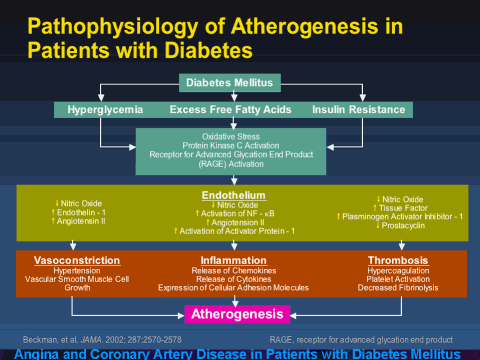| front |1 |2 |3 |4 |5 |6 |7 |8 |9 |10 |11 |12 |13 |14 |15 |16 |17 |18 |19 |20 |21 |22 |23 |24 |review |
 |
In diabetes,
hyperglycemia, excess free fatty acid release, and insulin resistance
engender adverse metabolic events within the endothelial cell. Activation of
these systems impairs endothelial function, augments vasoconstriction,
increases inflammation, and promotes thrombosis and thus renders arteries
susceptible to atherosclerosis.1 Postprandial increases in plasma glucose, free fatty acids, and insulin concentrations in diabetic patients suppress endothelium-mediated vasodilation by decreasing bioavailability of endothelium-derived nitric oxide.1 In patients with type 2 diabetes, this suppression of endothelium-mediated vasodilation is of greater severity and longer duration than in individuals with normal glucose tolerance.2 Postprandial increases in serum glucose, low-density lipoprotein cholesterol, and insulin concentrations can also lead to vasoconstriction mediated by increased expression of endothelin-1, angiotensin II, and prostanoids.2 These changes augment immune and inflammatory responses that contribute to atherogenesis. [1] Beckman, et al. Diabetes and atherosclerosis: epidemiology, pathophysiology, and management. JAMA. 2002; 287:2570-2581 [2] Nesto. Correlation between cardiovascular disease and diabetes mellitus: current concepts. Am J Med. 2004; 116(suppl 5A):11S-22S |